Study of Different Diseases: Vaccines, Durability, Side Effects, and More
VerifiedAdded on 2022/12/27
|7
|1581
|99
AI Summary
This report provides a comprehensive study of seven different diseases, including tuberculosis, influenza, athletes foot, malaria, round worm, diarrhea, and HIV. It covers topics such as vaccines available, durability of vaccines, side effects, cost barriers, and social, cultural, or religious issues associated with treatment.
Contribute Materials
Your contribution can guide someone’s learning journey. Share your
documents today.

ASSESSMENT
1
1
Secure Best Marks with AI Grader
Need help grading? Try our AI Grader for instant feedback on your assignments.
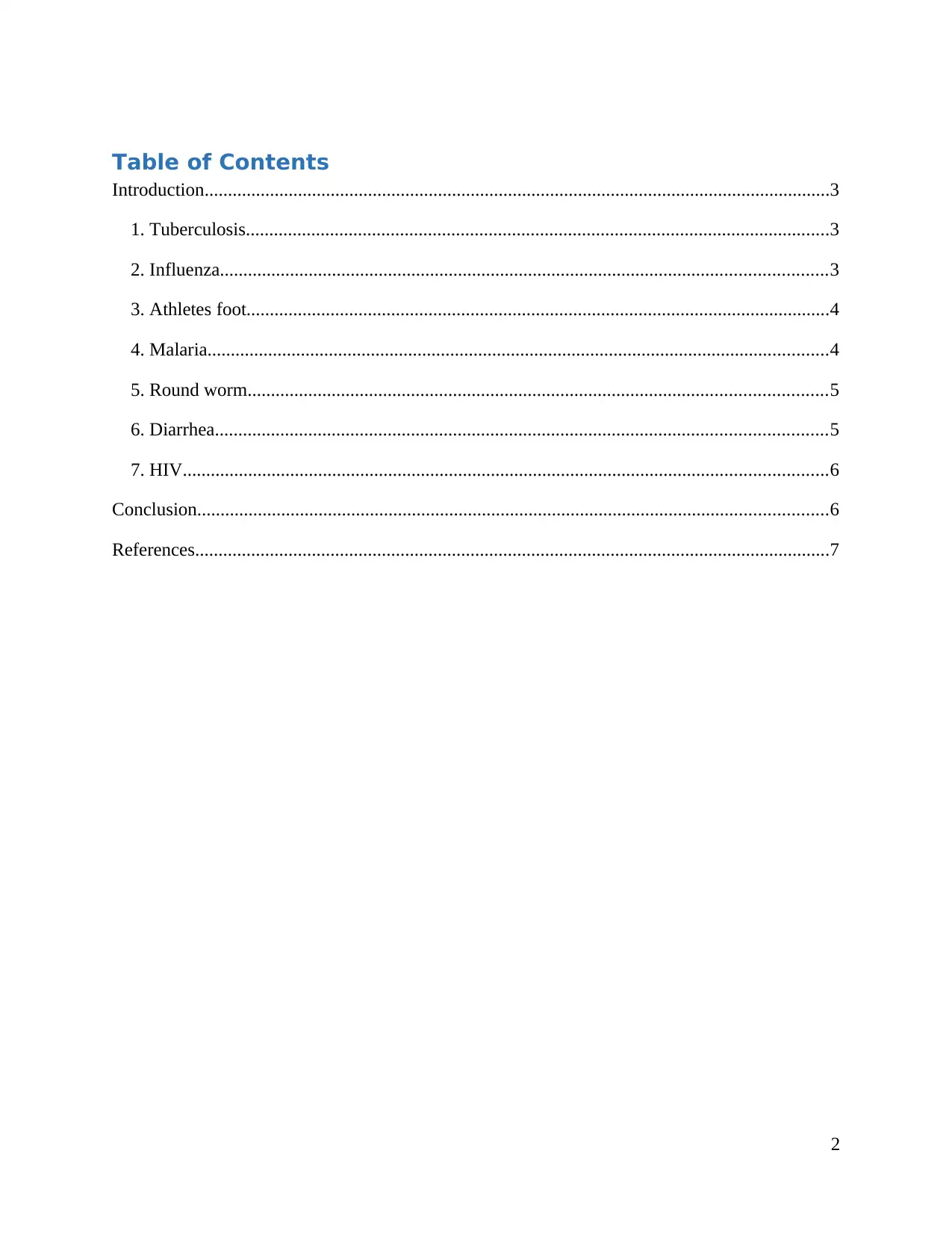
Table of Contents
Introduction......................................................................................................................................3
1. Tuberculosis.............................................................................................................................3
2. Influenza..................................................................................................................................3
3. Athletes foot.............................................................................................................................4
4. Malaria.....................................................................................................................................4
5. Round worm............................................................................................................................5
6. Diarrhea...................................................................................................................................5
7. HIV..........................................................................................................................................6
Conclusion.......................................................................................................................................6
References........................................................................................................................................7
2
Introduction......................................................................................................................................3
1. Tuberculosis.............................................................................................................................3
2. Influenza..................................................................................................................................3
3. Athletes foot.............................................................................................................................4
4. Malaria.....................................................................................................................................4
5. Round worm............................................................................................................................5
6. Diarrhea...................................................................................................................................5
7. HIV..........................................................................................................................................6
Conclusion.......................................................................................................................................6
References........................................................................................................................................7
2
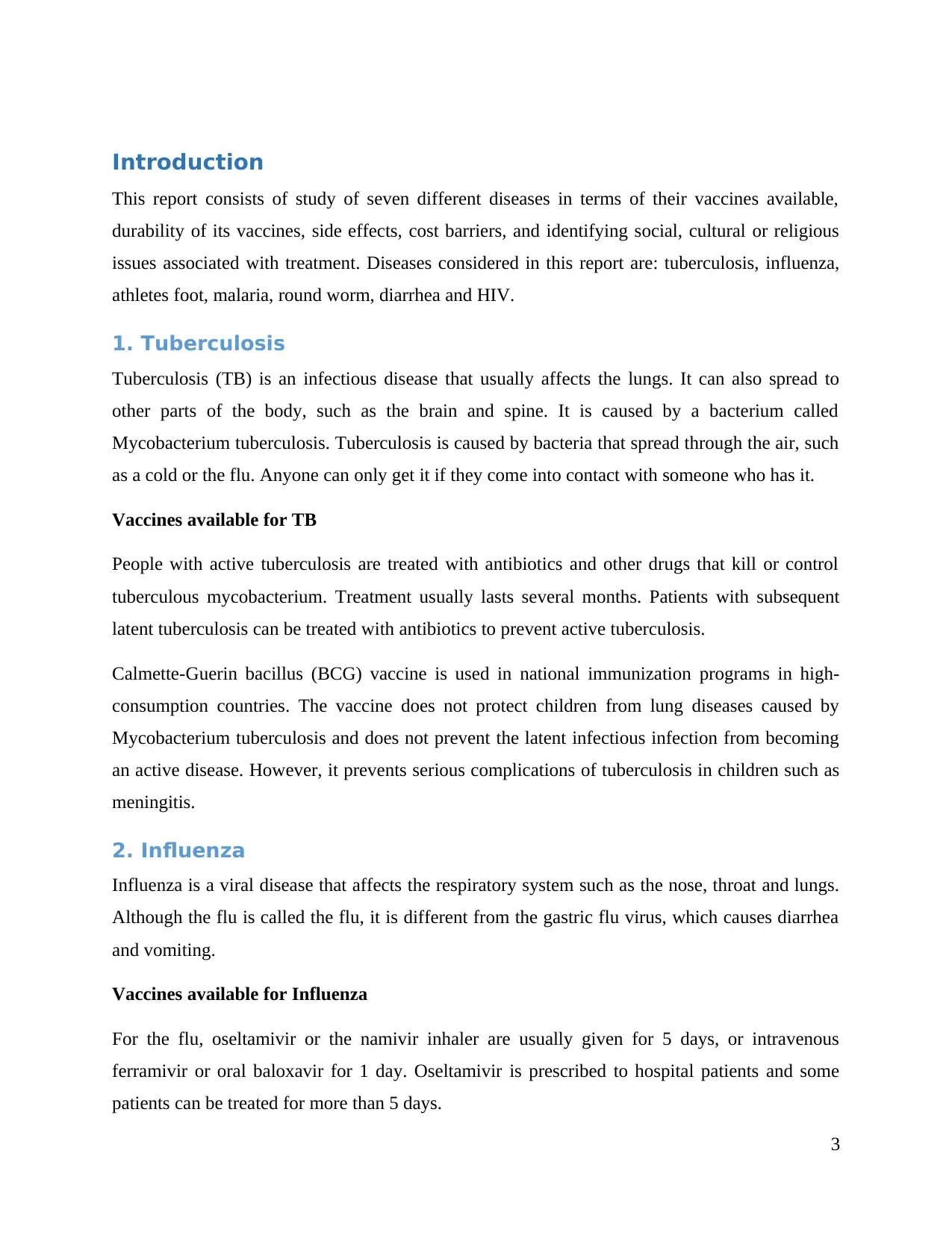
Introduction
This report consists of study of seven different diseases in terms of their vaccines available,
durability of its vaccines, side effects, cost barriers, and identifying social, cultural or religious
issues associated with treatment. Diseases considered in this report are: tuberculosis, influenza,
athletes foot, malaria, round worm, diarrhea and HIV.
1. Tuberculosis
Tuberculosis (TB) is an infectious disease that usually affects the lungs. It can also spread to
other parts of the body, such as the brain and spine. It is caused by a bacterium called
Mycobacterium tuberculosis. Tuberculosis is caused by bacteria that spread through the air, such
as a cold or the flu. Anyone can only get it if they come into contact with someone who has it.
Vaccines available for TB
People with active tuberculosis are treated with antibiotics and other drugs that kill or control
tuberculous mycobacterium. Treatment usually lasts several months. Patients with subsequent
latent tuberculosis can be treated with antibiotics to prevent active tuberculosis.
Calmette-Guerin bacillus (BCG) vaccine is used in national immunization programs in high-
consumption countries. The vaccine does not protect children from lung diseases caused by
Mycobacterium tuberculosis and does not prevent the latent infectious infection from becoming
an active disease. However, it prevents serious complications of tuberculosis in children such as
meningitis.
2. Influenza
Influenza is a viral disease that affects the respiratory system such as the nose, throat and lungs.
Although the flu is called the flu, it is different from the gastric flu virus, which causes diarrhea
and vomiting.
Vaccines available for Influenza
For the flu, oseltamivir or the namivir inhaler are usually given for 5 days, or intravenous
ferramivir or oral baloxavir for 1 day. Oseltamivir is prescribed to hospital patients and some
patients can be treated for more than 5 days.
3
This report consists of study of seven different diseases in terms of their vaccines available,
durability of its vaccines, side effects, cost barriers, and identifying social, cultural or religious
issues associated with treatment. Diseases considered in this report are: tuberculosis, influenza,
athletes foot, malaria, round worm, diarrhea and HIV.
1. Tuberculosis
Tuberculosis (TB) is an infectious disease that usually affects the lungs. It can also spread to
other parts of the body, such as the brain and spine. It is caused by a bacterium called
Mycobacterium tuberculosis. Tuberculosis is caused by bacteria that spread through the air, such
as a cold or the flu. Anyone can only get it if they come into contact with someone who has it.
Vaccines available for TB
People with active tuberculosis are treated with antibiotics and other drugs that kill or control
tuberculous mycobacterium. Treatment usually lasts several months. Patients with subsequent
latent tuberculosis can be treated with antibiotics to prevent active tuberculosis.
Calmette-Guerin bacillus (BCG) vaccine is used in national immunization programs in high-
consumption countries. The vaccine does not protect children from lung diseases caused by
Mycobacterium tuberculosis and does not prevent the latent infectious infection from becoming
an active disease. However, it prevents serious complications of tuberculosis in children such as
meningitis.
2. Influenza
Influenza is a viral disease that affects the respiratory system such as the nose, throat and lungs.
Although the flu is called the flu, it is different from the gastric flu virus, which causes diarrhea
and vomiting.
Vaccines available for Influenza
For the flu, oseltamivir or the namivir inhaler are usually given for 5 days, or intravenous
ferramivir or oral baloxavir for 1 day. Oseltamivir is prescribed to hospital patients and some
patients can be treated for more than 5 days.
3
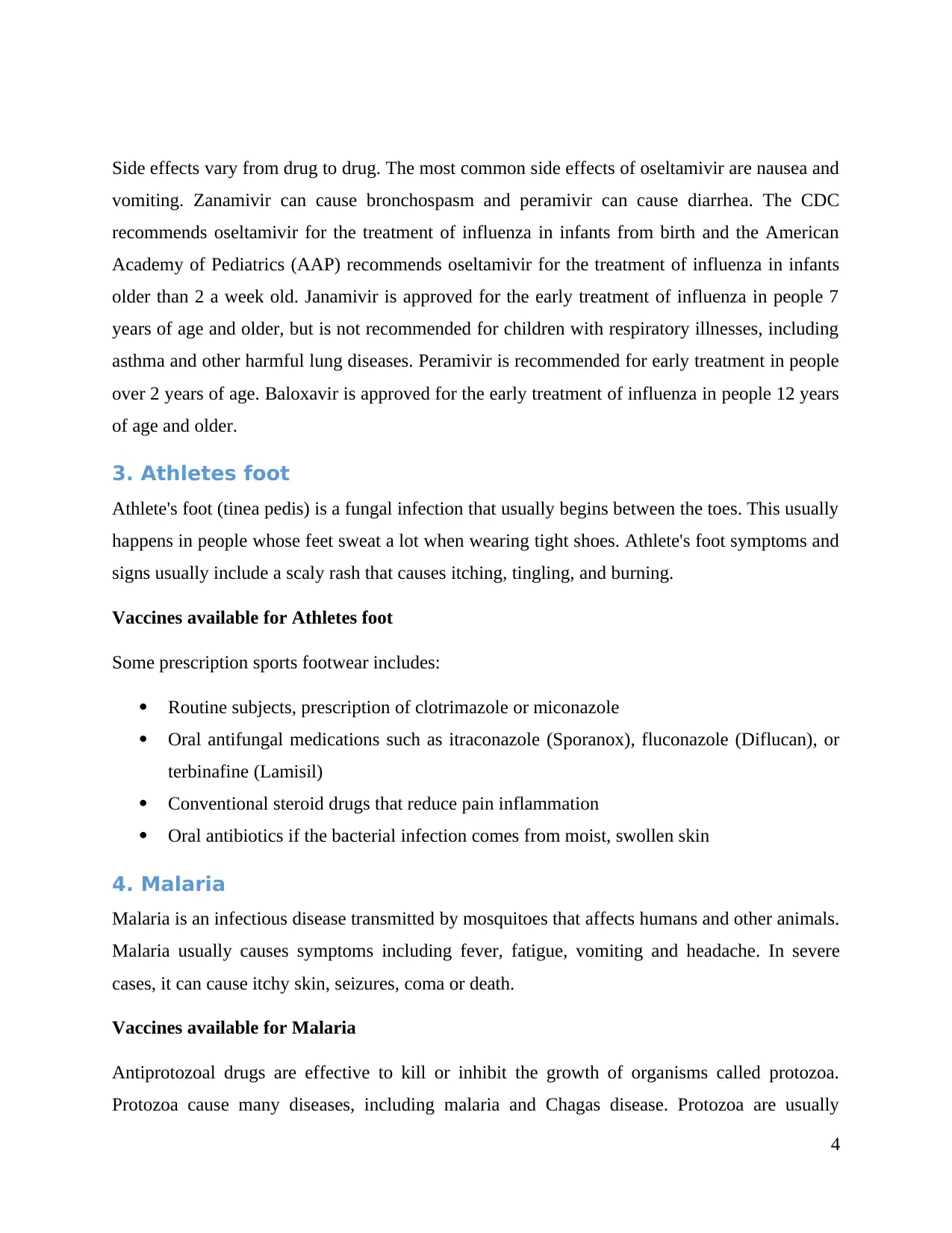
Side effects vary from drug to drug. The most common side effects of oseltamivir are nausea and
vomiting. Zanamivir can cause bronchospasm and peramivir can cause diarrhea. The CDC
recommends oseltamivir for the treatment of influenza in infants from birth and the American
Academy of Pediatrics (AAP) recommends oseltamivir for the treatment of influenza in infants
older than 2 a week old. Janamivir is approved for the early treatment of influenza in people 7
years of age and older, but is not recommended for children with respiratory illnesses, including
asthma and other harmful lung diseases. Peramivir is recommended for early treatment in people
over 2 years of age. Baloxavir is approved for the early treatment of influenza in people 12 years
of age and older.
3. Athletes foot
Athlete's foot (tinea pedis) is a fungal infection that usually begins between the toes. This usually
happens in people whose feet sweat a lot when wearing tight shoes. Athlete's foot symptoms and
signs usually include a scaly rash that causes itching, tingling, and burning.
Vaccines available for Athletes foot
Some prescription sports footwear includes:
Routine subjects, prescription of clotrimazole or miconazole
Oral antifungal medications such as itraconazole (Sporanox), fluconazole (Diflucan), or
terbinafine (Lamisil)
Conventional steroid drugs that reduce pain inflammation
Oral antibiotics if the bacterial infection comes from moist, swollen skin
4. Malaria
Malaria is an infectious disease transmitted by mosquitoes that affects humans and other animals.
Malaria usually causes symptoms including fever, fatigue, vomiting and headache. In severe
cases, it can cause itchy skin, seizures, coma or death.
Vaccines available for Malaria
Antiprotozoal drugs are effective to kill or inhibit the growth of organisms called protozoa.
Protozoa cause many diseases, including malaria and Chagas disease. Protozoa are usually
4
vomiting. Zanamivir can cause bronchospasm and peramivir can cause diarrhea. The CDC
recommends oseltamivir for the treatment of influenza in infants from birth and the American
Academy of Pediatrics (AAP) recommends oseltamivir for the treatment of influenza in infants
older than 2 a week old. Janamivir is approved for the early treatment of influenza in people 7
years of age and older, but is not recommended for children with respiratory illnesses, including
asthma and other harmful lung diseases. Peramivir is recommended for early treatment in people
over 2 years of age. Baloxavir is approved for the early treatment of influenza in people 12 years
of age and older.
3. Athletes foot
Athlete's foot (tinea pedis) is a fungal infection that usually begins between the toes. This usually
happens in people whose feet sweat a lot when wearing tight shoes. Athlete's foot symptoms and
signs usually include a scaly rash that causes itching, tingling, and burning.
Vaccines available for Athletes foot
Some prescription sports footwear includes:
Routine subjects, prescription of clotrimazole or miconazole
Oral antifungal medications such as itraconazole (Sporanox), fluconazole (Diflucan), or
terbinafine (Lamisil)
Conventional steroid drugs that reduce pain inflammation
Oral antibiotics if the bacterial infection comes from moist, swollen skin
4. Malaria
Malaria is an infectious disease transmitted by mosquitoes that affects humans and other animals.
Malaria usually causes symptoms including fever, fatigue, vomiting and headache. In severe
cases, it can cause itchy skin, seizures, coma or death.
Vaccines available for Malaria
Antiprotozoal drugs are effective to kill or inhibit the growth of organisms called protozoa.
Protozoa cause many diseases, including malaria and Chagas disease. Protozoa are usually
4
Secure Best Marks with AI Grader
Need help grading? Try our AI Grader for instant feedback on your assignments.
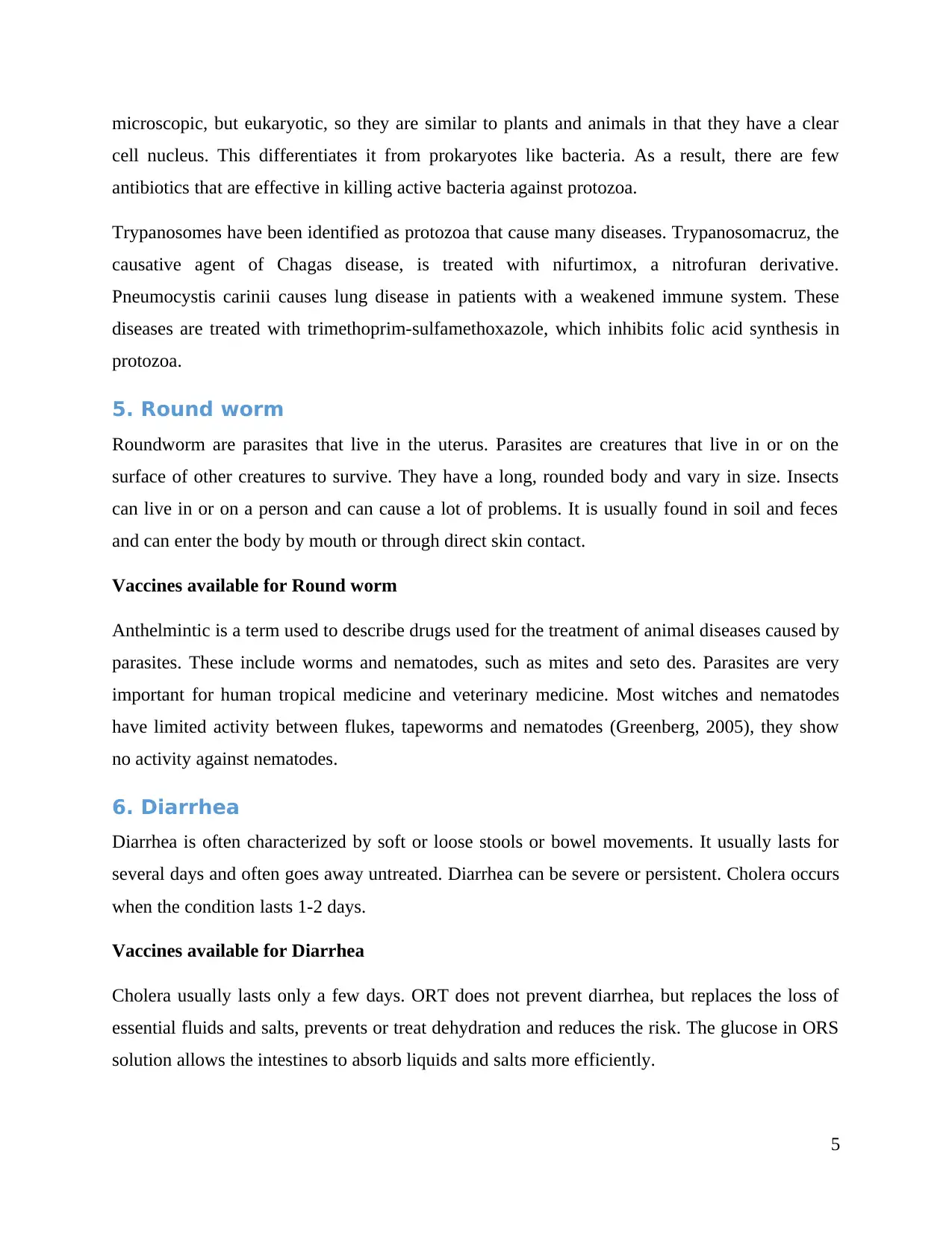
microscopic, but eukaryotic, so they are similar to plants and animals in that they have a clear
cell nucleus. This differentiates it from prokaryotes like bacteria. As a result, there are few
antibiotics that are effective in killing active bacteria against protozoa.
Trypanosomes have been identified as protozoa that cause many diseases. Trypanosomacruz, the
causative agent of Chagas disease, is treated with nifurtimox, a nitrofuran derivative.
Pneumocystis carinii causes lung disease in patients with a weakened immune system. These
diseases are treated with trimethoprim-sulfamethoxazole, which inhibits folic acid synthesis in
protozoa.
5. Round worm
Roundworm are parasites that live in the uterus. Parasites are creatures that live in or on the
surface of other creatures to survive. They have a long, rounded body and vary in size. Insects
can live in or on a person and can cause a lot of problems. It is usually found in soil and feces
and can enter the body by mouth or through direct skin contact.
Vaccines available for Round worm
Anthelmintic is a term used to describe drugs used for the treatment of animal diseases caused by
parasites. These include worms and nematodes, such as mites and seto des. Parasites are very
important for human tropical medicine and veterinary medicine. Most witches and nematodes
have limited activity between flukes, tapeworms and nematodes (Greenberg, 2005), they show
no activity against nematodes.
6. Diarrhea
Diarrhea is often characterized by soft or loose stools or bowel movements. It usually lasts for
several days and often goes away untreated. Diarrhea can be severe or persistent. Cholera occurs
when the condition lasts 1-2 days.
Vaccines available for Diarrhea
Cholera usually lasts only a few days. ORT does not prevent diarrhea, but replaces the loss of
essential fluids and salts, prevents or treat dehydration and reduces the risk. The glucose in ORS
solution allows the intestines to absorb liquids and salts more efficiently.
5
cell nucleus. This differentiates it from prokaryotes like bacteria. As a result, there are few
antibiotics that are effective in killing active bacteria against protozoa.
Trypanosomes have been identified as protozoa that cause many diseases. Trypanosomacruz, the
causative agent of Chagas disease, is treated with nifurtimox, a nitrofuran derivative.
Pneumocystis carinii causes lung disease in patients with a weakened immune system. These
diseases are treated with trimethoprim-sulfamethoxazole, which inhibits folic acid synthesis in
protozoa.
5. Round worm
Roundworm are parasites that live in the uterus. Parasites are creatures that live in or on the
surface of other creatures to survive. They have a long, rounded body and vary in size. Insects
can live in or on a person and can cause a lot of problems. It is usually found in soil and feces
and can enter the body by mouth or through direct skin contact.
Vaccines available for Round worm
Anthelmintic is a term used to describe drugs used for the treatment of animal diseases caused by
parasites. These include worms and nematodes, such as mites and seto des. Parasites are very
important for human tropical medicine and veterinary medicine. Most witches and nematodes
have limited activity between flukes, tapeworms and nematodes (Greenberg, 2005), they show
no activity against nematodes.
6. Diarrhea
Diarrhea is often characterized by soft or loose stools or bowel movements. It usually lasts for
several days and often goes away untreated. Diarrhea can be severe or persistent. Cholera occurs
when the condition lasts 1-2 days.
Vaccines available for Diarrhea
Cholera usually lasts only a few days. ORT does not prevent diarrhea, but replaces the loss of
essential fluids and salts, prevents or treat dehydration and reduces the risk. The glucose in ORS
solution allows the intestines to absorb liquids and salts more efficiently.
5
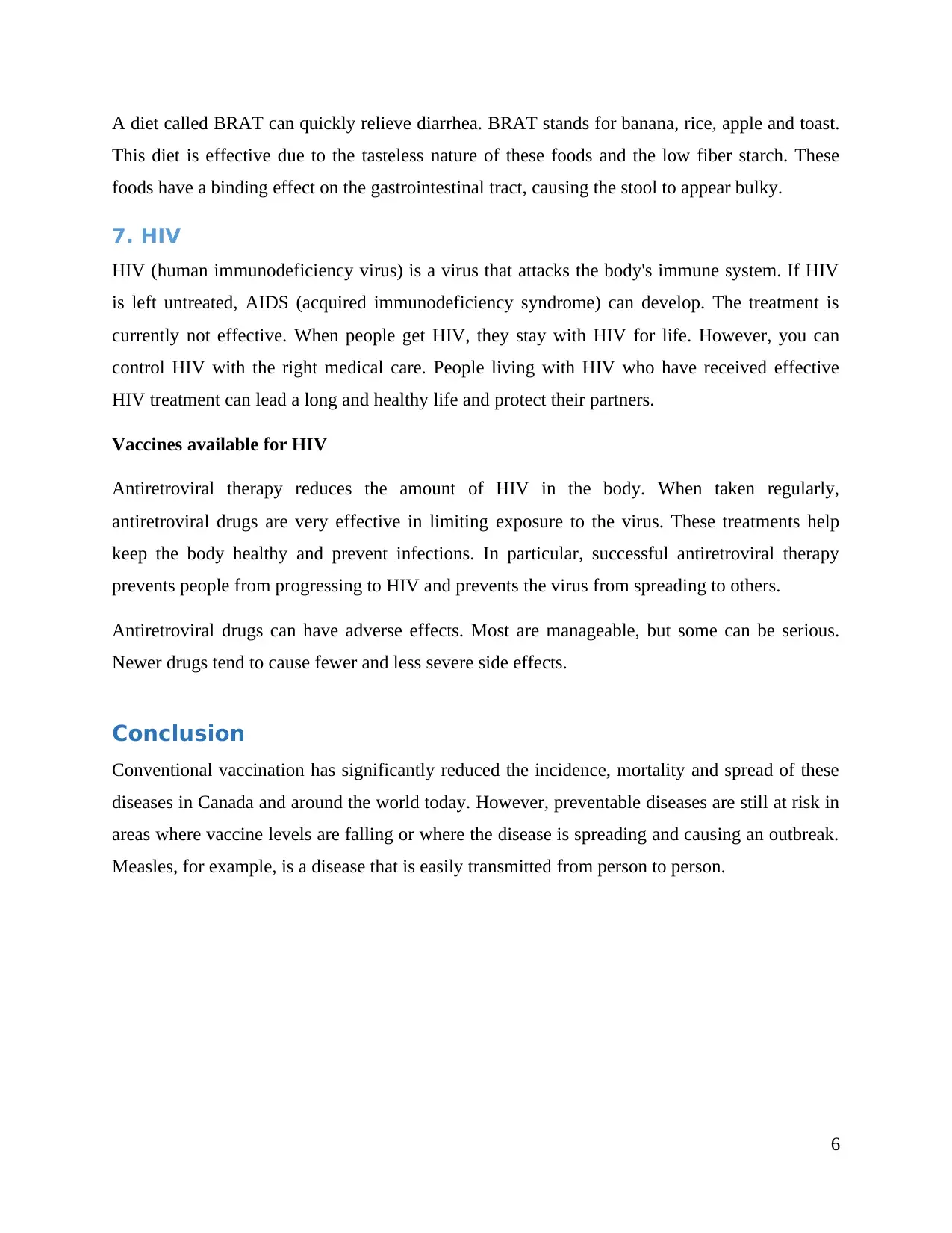
A diet called BRAT can quickly relieve diarrhea. BRAT stands for banana, rice, apple and toast.
This diet is effective due to the tasteless nature of these foods and the low fiber starch. These
foods have a binding effect on the gastrointestinal tract, causing the stool to appear bulky.
7. HIV
HIV (human immunodeficiency virus) is a virus that attacks the body's immune system. If HIV
is left untreated, AIDS (acquired immunodeficiency syndrome) can develop. The treatment is
currently not effective. When people get HIV, they stay with HIV for life. However, you can
control HIV with the right medical care. People living with HIV who have received effective
HIV treatment can lead a long and healthy life and protect their partners.
Vaccines available for HIV
Antiretroviral therapy reduces the amount of HIV in the body. When taken regularly,
antiretroviral drugs are very effective in limiting exposure to the virus. These treatments help
keep the body healthy and prevent infections. In particular, successful antiretroviral therapy
prevents people from progressing to HIV and prevents the virus from spreading to others.
Antiretroviral drugs can have adverse effects. Most are manageable, but some can be serious.
Newer drugs tend to cause fewer and less severe side effects.
Conclusion
Conventional vaccination has significantly reduced the incidence, mortality and spread of these
diseases in Canada and around the world today. However, preventable diseases are still at risk in
areas where vaccine levels are falling or where the disease is spreading and causing an outbreak.
Measles, for example, is a disease that is easily transmitted from person to person.
6
This diet is effective due to the tasteless nature of these foods and the low fiber starch. These
foods have a binding effect on the gastrointestinal tract, causing the stool to appear bulky.
7. HIV
HIV (human immunodeficiency virus) is a virus that attacks the body's immune system. If HIV
is left untreated, AIDS (acquired immunodeficiency syndrome) can develop. The treatment is
currently not effective. When people get HIV, they stay with HIV for life. However, you can
control HIV with the right medical care. People living with HIV who have received effective
HIV treatment can lead a long and healthy life and protect their partners.
Vaccines available for HIV
Antiretroviral therapy reduces the amount of HIV in the body. When taken regularly,
antiretroviral drugs are very effective in limiting exposure to the virus. These treatments help
keep the body healthy and prevent infections. In particular, successful antiretroviral therapy
prevents people from progressing to HIV and prevents the virus from spreading to others.
Antiretroviral drugs can have adverse effects. Most are manageable, but some can be serious.
Newer drugs tend to cause fewer and less severe side effects.
Conclusion
Conventional vaccination has significantly reduced the incidence, mortality and spread of these
diseases in Canada and around the world today. However, preventable diseases are still at risk in
areas where vaccine levels are falling or where the disease is spreading and causing an outbreak.
Measles, for example, is a disease that is easily transmitted from person to person.
6
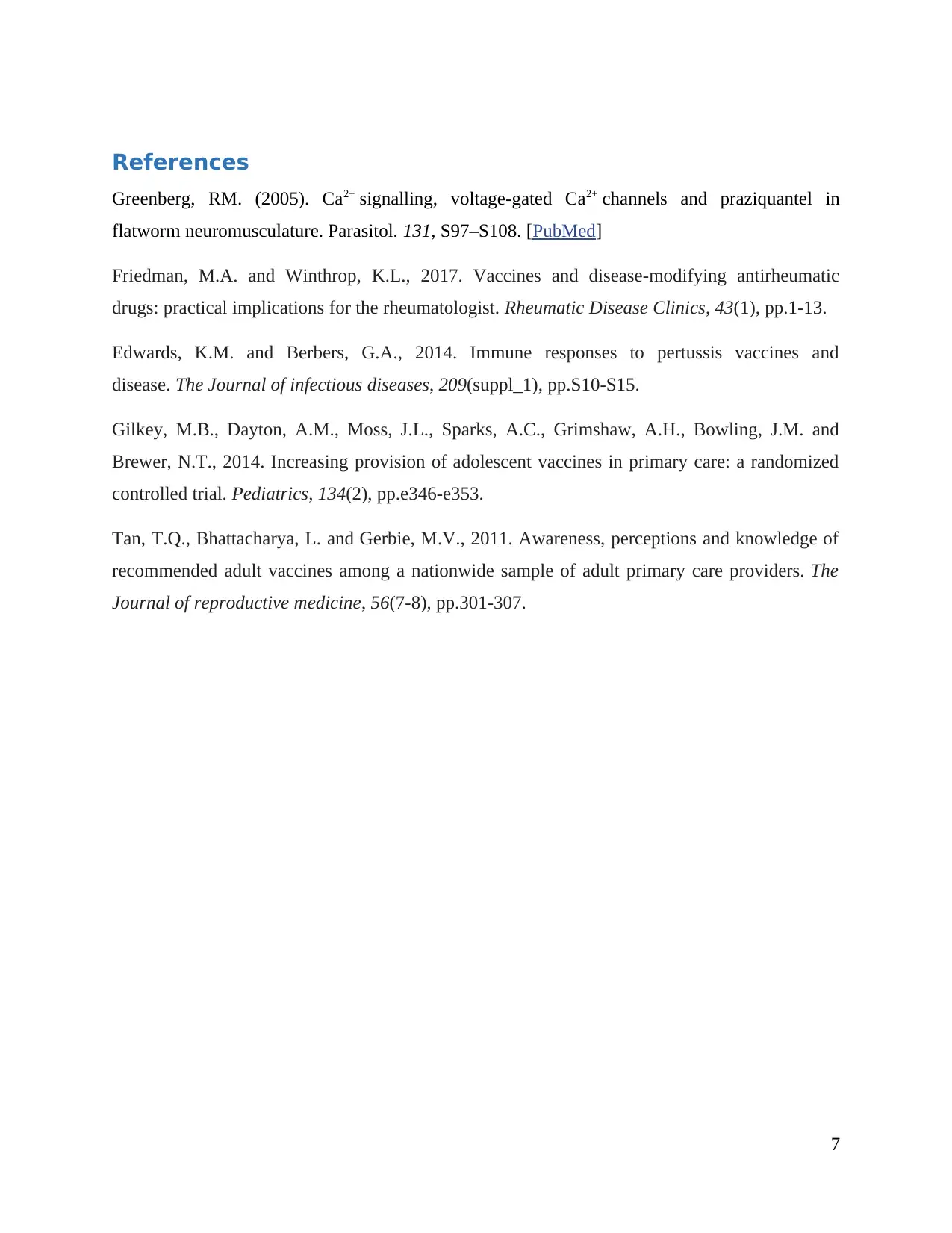
References
Greenberg, RM. (2005). Ca2+ signalling, voltage-gated Ca2+ channels and praziquantel in
flatworm neuromusculature. Parasitol. 131, S97–S108. [PubMed]
Friedman, M.A. and Winthrop, K.L., 2017. Vaccines and disease-modifying antirheumatic
drugs: practical implications for the rheumatologist. Rheumatic Disease Clinics, 43(1), pp.1-13.
Edwards, K.M. and Berbers, G.A., 2014. Immune responses to pertussis vaccines and
disease. The Journal of infectious diseases, 209(suppl_1), pp.S10-S15.
Gilkey, M.B., Dayton, A.M., Moss, J.L., Sparks, A.C., Grimshaw, A.H., Bowling, J.M. and
Brewer, N.T., 2014. Increasing provision of adolescent vaccines in primary care: a randomized
controlled trial. Pediatrics, 134(2), pp.e346-e353.
Tan, T.Q., Bhattacharya, L. and Gerbie, M.V., 2011. Awareness, perceptions and knowledge of
recommended adult vaccines among a nationwide sample of adult primary care providers. The
Journal of reproductive medicine, 56(7-8), pp.301-307.
7
Greenberg, RM. (2005). Ca2+ signalling, voltage-gated Ca2+ channels and praziquantel in
flatworm neuromusculature. Parasitol. 131, S97–S108. [PubMed]
Friedman, M.A. and Winthrop, K.L., 2017. Vaccines and disease-modifying antirheumatic
drugs: practical implications for the rheumatologist. Rheumatic Disease Clinics, 43(1), pp.1-13.
Edwards, K.M. and Berbers, G.A., 2014. Immune responses to pertussis vaccines and
disease. The Journal of infectious diseases, 209(suppl_1), pp.S10-S15.
Gilkey, M.B., Dayton, A.M., Moss, J.L., Sparks, A.C., Grimshaw, A.H., Bowling, J.M. and
Brewer, N.T., 2014. Increasing provision of adolescent vaccines in primary care: a randomized
controlled trial. Pediatrics, 134(2), pp.e346-e353.
Tan, T.Q., Bhattacharya, L. and Gerbie, M.V., 2011. Awareness, perceptions and knowledge of
recommended adult vaccines among a nationwide sample of adult primary care providers. The
Journal of reproductive medicine, 56(7-8), pp.301-307.
7
1 out of 7
Your All-in-One AI-Powered Toolkit for Academic Success.
+13062052269
info@desklib.com
Available 24*7 on WhatsApp / Email
![[object Object]](/_next/static/media/star-bottom.7253800d.svg)
Unlock your academic potential
© 2024 | Zucol Services PVT LTD | All rights reserved.

